Unveiling the Secrets to Restoring Old Cars: A Guide to Reviving Automotive History
Can you breathe life back into a vintage masterpiece? Restoring old cars isn't just about fixing them up; it's about preserving automotive history and creating a timeless treasure. Editor Note: This guide offers a comprehensive exploration of the art and science of restoring old cars, from the initial assessment to the final polish.
This is a must-read for anyone looking to revive their classic car or embark on a rewarding project. It delves into the intricate details, challenges, and triumphs of restoring these automotive gems, equipping you with the knowledge to embark on your own journey.
Our analysis involved researching various restoration techniques, examining the impact of different materials and processes, and studying successful restorations to create a step-by-step guide. Whether you're a seasoned enthusiast or a novice, this guide will provide the insights you need to approach this exciting endeavor with confidence.
Here are the key elements to consider when restoring an old car:
| Key Element | Description |
|---|---|
| Initial Assessment | Evaluating the car's condition, identifying areas needing restoration, and setting goals. |
| Disassembly | Separating components for cleaning, restoration, or replacement. |
| Bodywork | Addressing rust, dents, and imperfections to restore the car's original shape. |
| Paint | Choosing the right paint, applying it flawlessly, and achieving the desired finish. |
| Engine & Drivetrain | Rebuilding or repairing the engine, transmission, and other mechanical components. |
| Interior | Restoring or replacing the upholstery, seats, dashboard, and other interior elements. |
| Final Assembly | Putting everything back together, ensuring proper alignment and functionality. |
Restoring Old Cars: A Deep Dive into the Process
Initial Assessment: This stage is crucial for setting realistic expectations and planning the restoration journey. Thoroughly examine the car's condition, identify areas requiring attention, and prioritize tasks based on their urgency.
Disassembly: Carefully disassemble the car to allow for thorough cleaning, restoration, and replacement of parts. This process requires patience and meticulous documentation to ensure proper reassembly.
Bodywork: This is a critical stage where you address any rust, dents, and imperfections in the car's body. Techniques like metalwork, sanding, and priming are used to restore the original shape and prepare the surface for paint.
Paint: Choosing the right paint type and color is crucial for maintaining the car's authenticity. Applying the paint requires skill and attention to detail to achieve a flawless finish that enhances the car's beauty.
Engine & Drivetrain: Rebuilding or repairing the engine and drivetrain is a demanding task, requiring expertise in mechanics. This step involves inspecting and replacing worn-out parts, ensuring smooth operation and optimal performance.
Interior: The interior restoration focuses on bringing the car's cabin back to its original glory. This can involve restoring or replacing the upholstery, seats, dashboard, and other interior elements, preserving the car's character.
Final Assembly: This stage involves putting everything back together, ensuring proper alignment and functionality. Thorough testing is essential to ensure all components work seamlessly and the car is roadworthy.
Restoring Old Cars: A Journey of Passion and Skill
Restoring old cars is a challenging yet rewarding endeavor that requires passion, patience, and a dedication to detail. It's an opportunity to connect with automotive history and create a timeless masterpiece. As you delve into each stage of the process, remember that the journey is as important as the destination.
FAQ
Q: What are some common challenges encountered during old car restoration?
A: Challenges include sourcing rare parts, tackling complex mechanical issues, dealing with rust, and finding skilled technicians.
Q: What are the benefits of restoring an old car?
A: Benefits include preserving automotive history, creating a unique and valuable asset, and experiencing the joy of driving a classic car.
Q: Is it worth restoring an old car?
A: The value of a restoration depends on the car's rarity, condition, and the quality of the work. A well-restored car can appreciate in value over time.
Tips for Restoring Old Cars
- Research: Thoroughly research your car model, its history, and common restoration challenges.
- Budget: Create a realistic budget, accounting for parts, labor, and unexpected costs.
- Patience: Restoring an old car takes time. Be patient and enjoy the process.
- Expertise: Seek help from experienced mechanics, bodywork specialists, and restoration experts.
- Documentation: Document your progress, take photos, and keep a detailed log of repairs.
Summary
Restoring old cars is a rewarding endeavor that allows you to preserve automotive history and create a timeless treasure. By understanding the key elements of restoration and approaching the process with passion, patience, and attention to detail, you can successfully revive your classic car and enjoy the fruits of your labor.
Closing Message As you embark on your restoration journey, remember that the process is as important as the outcome. Embrace the challenges, learn from your experiences, and revel in the satisfaction of breathing new life into a timeless automotive masterpiece.

